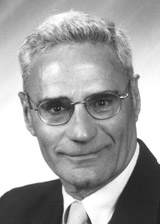
Fund Purpose:
This fund was formed to recognize the contribution of Dr. Jim Lauderdale to the field of reproductive physiology and to the American Society of Animal Science. Money from the club is used every three years to help support the Triennial Reproduction Symposium. In addition, money from this fund will now be used to support the ASAS Animal Physiology & Endocrinology Award.
Biographical Sketch:
Dr. Jim Lauderdale's contributions to our scientific community and to the animal industry are appreciated. One key scientific contribution was his leadership to develop and obtain regulatory approval for Lutalyse. Throughout his career, especially during the past two decades, Jim performed exemplary service to ASAS, including his presidency of ASAS and FASS. He generously contributed his time and talents to many individuals and companies.
Founders:
Deepest appreciation is expressed to the generous contributors and to John Chenault, Mel DeJarnette, Harold Hafs, Mike Moseley, David Patterson, and Bob Zimbelman for the success of funding this club.
Past Symposia:
2020 Triennial Reproduction Symposium Session I: Developmental Programming/Male Reproduction
- A. Watkins - Paternal Programming of Offspring Health
- R. M. Rivera - Epigenetic basis of congenital overgrowth syndromes in cattle: link to assisted reproduction
- D. Kenny - Early life nutrition on the molecular control of sexual development in the bull
- D. Miller - Sperm movement, storage, and release from the oviduct
2020 Triennial Reproduction Symposium Session II: Cell to Cell Interactions
- F. Perecin - Germ and somatic cell interactions during oocyte development and maturation
- M. Binelli - The dynamic blastocyst-endometrium interface in cattle
- G. Johnson - Steroids Regulate SLC2A1 and SLC2A3 to Deliver Glucose into Trophectoderm for Metabolism via Glycolysis
2017 Triennial Reproduction Symposium
- M. Smith - Reproduction in Domestic Ruminants during the Past 50 Years: Discovery to Application
- M. Andre Sirard - Prime Eggs from Prime Cows
- J. Hernandez Gifford - Wnt's Role in Folliculogenesis
- B. Alexander - Male Reproductive Behavior: Pathways and Messengers
- D. Yates - Fetal Origins of Impaired Muscle Growth and Metabolic Dysfunction: Lessons from the Heat-Stressed Pregnant Ewe
- K. Imakawa - Working towards more continuos model of conceptus implantation and placentation in ruminants
2015 Triennial Reproduction Symposium: Developmental Programming of Fertility
- L. Reynolds - The importance for understanding developmental programming impacts on fertility: An overview
- A. Roberts - Beef heifer development systems and lifetime productivity
- L. DeBrito - Effects of prenatal/neonatal nutrition on reproductive characteristics of adult bulls
- G. Williams - Nutritional programming of reproductive function in heifers
- M. Estienne - Environmental contaminants and developmental programming in livestock
- J. Schneider - Developmental programming of fertility in amphibians
- M. Skinner - Epigenetic programming of postnatal testicular function
- F. vom Saal - Environmental effects on programming of reproductive behavior
- N. Evans - Environmental contaminants and programming of livestock
- L. Reynolds - Summary
2012 Triennial Reproduction Symposium: Impediments to Fertility in Domestic Animals
- M. D. Utt and M. L. Day - Obstacle course to successful establishment of pregnancy in domestic livestock species.
- W. L. Flowers - Characteristics that limit success of fertilization.
- J. E. Fortune, M. Y. Yang, and J. J. Allen - Ovarian follicular reserve in ruminants: What regulates its formation and size?
- T. W. Geary, M. F. Smith, M. D. MacNeil, M. L. Day, G. A. Bridges, G. A. Perry, F. M. Abreu, J. A. Atkins, K. G. Pohler, E. M. Jinks, and C. A. Roberts - Influence of follicle characteristics at ovulation on early embryo survival.
- G. A. Bridges - Deficiencies in the uterine environment and failure to support embryo development.
- T. R. Hansen, A. Q. Antoniazzi, J. J. Romero, R. L. Ashley, and R. C. Bot - Interactions of the embryo, uterus and corpus luteum for sustenance of embryos.
- J. L. Vallet - Limitations in uterine and conceptus physiology that lead to fetal losses.
- R. L. A. Cerri, J. E. P. Santos, W. W. Thatcher, and J. L. M. Vasconcelos - The spectrum of factors that impede pregnancy in dairy cows.
2009 Triennial Reproduction Symposium: Triennial Reproduction Symposium: Challenges and Opportunities Facing Livestock Reproduction in the 21st Century. Session 1: Global perspectives on animal health and livestock reproduction
- R. D. Green - A global perspective on the evolution of animal agriculture.
- D. Wolfenson, Y. Lavon, R. Meidan, Z. Roth, and G. Leitner - Impact of animal health on endocrinology and reproduction in dairy cows.
- G. R. Foxcroft - Challenges in matching the physiology and productivity of the modern commercial sow.
- G. Wu, F. W. Bazer, G. A. Johnson, S. W. Kim, and T. E. Spencer - The impact of amino acid nutrition on pregnancy outcome in pigs: mechanisms and implications for swine production.
2009 Triennial Reproduction Symposium: Triennial Reproduction Symposium: Challenges and Opportunities Facing Livestock Reproduction in the 21st Century. Session 2: Genetic influences on animal reproduction
- J. F. Taylor, S. D. McKay, J. E. Decker, D. Vasco, M. C. McClure, J. W. Kim, M. A. Rolf, T. Taxis, and R. D. Schnabel - Application of genome based technologies for identifying genes and their expression that are important for livestock reproduction.
- T. Rathje - Application of molecular and genetic tools for identification of reproductive traits to create and establish commercial lines of swine.
- R. Lane, R. McKnight, L. Joss-Moore, Q. Fu, and X. Ke - Epigenetics: A mechanism of adaptation to perinatal events.
- R. N. Funston - Impact of dam nutrition on subsequent growth and reproduction in beef heifers.




